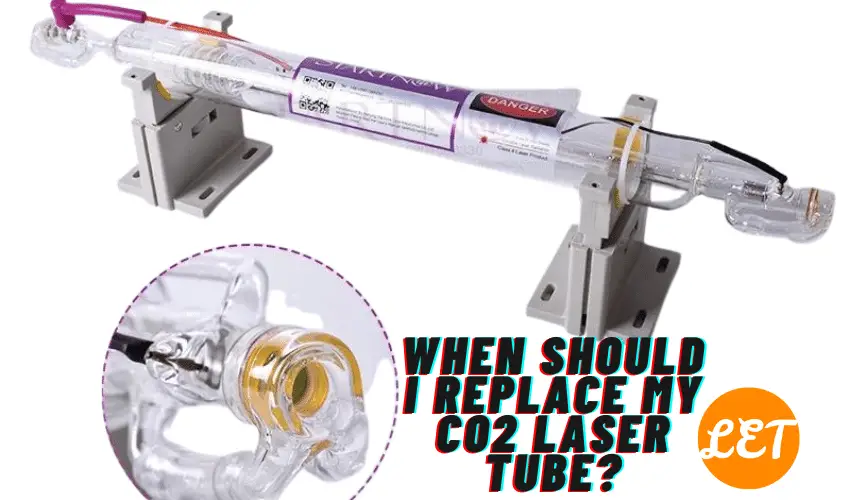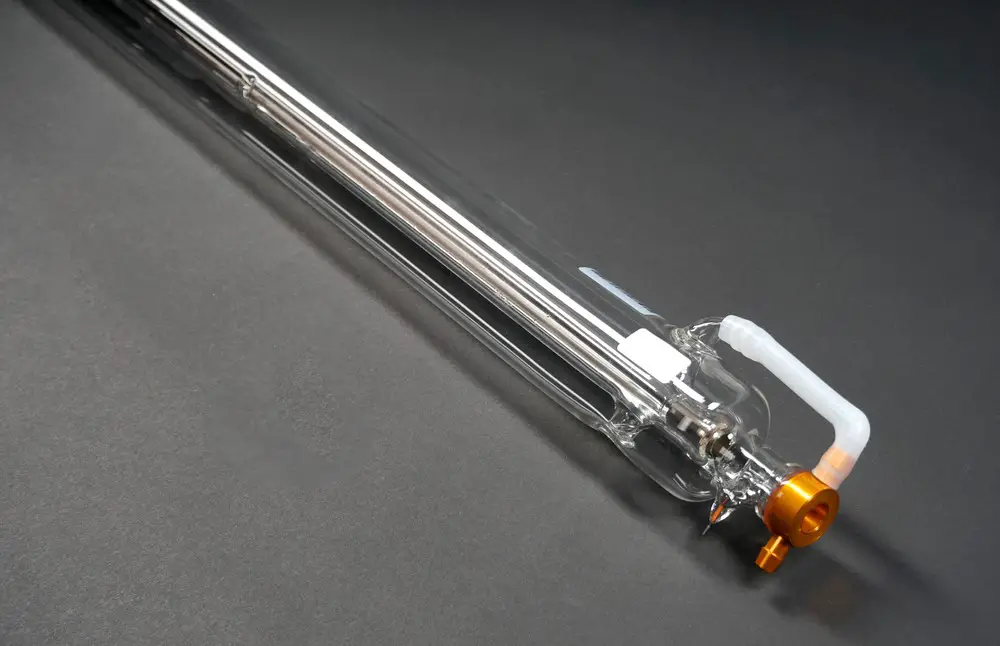If you’re running a CO2 laser system, such as a laser engraver or laser cutter, you know you will eventually have to replace the laser tube. How frequently that happens depends on the type of laser and how it is used.
Generally, most Glass CO2 laser tubes manufactured in China last anywhere from 1000-10000 hours before replacement is necessary. This can vary depending on the quality of the tube, how often it is used, and the maintenance of the tube.
In this post, I will be answering the question: when should I replace my CO2 laser tube?

When Should I Replace My CO2 Laser Tube?
For optimal performance, you need to replace your laser tube once it starts to degrade. Here are some telltale signs that it is time to replace your laser tube:
- The Laser Tube Has Lasted its Rated Life
Most Glass laser tubes manufactured in China last up to 1000 – 10000 hours, but the actual life of a tube depends on its quality and the maintenance it receives.
You can check with your supplier or company through their customer service department to check the actual life of your laser tube. They will often let you know how long your tube is rated to last, and when it should be replaced.

- There Has Been a Color Change
If there has been a color change in your laser tube, this is a sign that it should be replaced. It may also mean that you need to adjust the power of your laser if there has been a decrease in power output.
You should do a visual inspection to determine whether or not the gas in the tube is still okay. Start by opening the cover of your laser machine. Turn the current on and adjust it to normal. Now press the test button and look at the color of the CO2 laser tube.
If the color is white, then this is an indication that you might want to change the tube. If the color is pink, then your CO2 laser tube has some more life in it and you don’t need to replace the tube yet.
- The Performance is Decreasing
If the performance of your machine is decreasing, it could be due to a faulty laser tube. This can be caused by several things, such as age, excessive use, or improper maintenance.
You should take the time to inspect the laser tube and make sure it is in good working condition. If there are any signs of damage, you should replace the tube as soon as possible.
- The Focal Length Has Changed
If you notice that your machine’s focal length has changed, it is time to replace the laser tube. The focal length is the distance between the lens and the laser beam focus. This can affect your engraving or cutting results, so it is important to keep an eye on this.
You can check if the focal length is still correct by wiping the lens and then adjusting the light. If the focus of the beam is not where it should be, you may need to replace the tube.
- The Spot Test
Another way to know it is time to replace your laser tube is to do a spot test. This involves focusing the beam on a piece of paper or card and looking at how the spot is burnt.
Hold a card in front of your CO2 laser tube. Now press the test button for about a second and look at how much the spot is coke-burnt. If the spot is only lightly burnt, then your laser tube may be losing its power and should be replaced.
These are some of the things you should look out for when it comes to replacing your CO2 laser tube. If you notice any of these signs, it is best to replace the tube as soon as possible to ensure the optimal performance of your engraver or cutter.
Also Read: Why is my laser cutter not cutting?
How Do I Get My CO2 Laser Tube to Last Longer?

Before it is time to replace your CO2 laser tube, there are various things you need to do to make sure it lasts as long as possible.
Use the Correct Power Rating
Different laser machines require different power ratings for optimal performance. If you are using a machine that is too powerful, it can damage the laser tube and reduce its lifespan significantly.
Do not Overdrive the Laser Tube
One of the biggest mistakes people make is overdriving the laser tube. This means running the machine at a higher power setting than is necessary for the job, which can cause permanent damage to your laser tube.
Keep it Clean
Another important thing to do is to keep your machine clean and dust-free. This will help ensure that the laser tube operates without any issues. It is also important to regularly check for any signs of damage or wear and tear.
Note that you can also lose 9-13% of the laser power by having dirty lenses and mirrors. So you want to make sure you clean them regularly.
Fit a Milliammeter
Fitting a milliammeter can help you monitor the current of your laser tube and ensure that it is not being overdriven. This is an important tool, especially if the laser machine you are using does not have a current-limiting feature.
Check the Manufacturing Date
When buying a CO2 laser tube, it is always important to check the manufacturing date. You don’t want to buy a tube that is too old and therefore has less life in it.
By following all these steps, you can make sure your CO2 laser tube lasts as long as possible before needing to be replaced.
Also Read: Why is my laser leaving lines?
Final Thoughts
When it comes to replacing your CO2 laser tube, there are various indicators you should look out for. Generally, you should consider replacing your laser tube if it is not working at optimal performance, the focal length has changed, or it has lived through its expected lifespan.
It is also important to take steps to ensure your CO2 laser tube last as long as possible. Hopefully, this article has given you some useful tips on how to do this.
